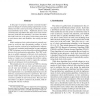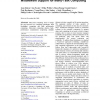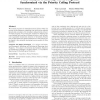724 search results - page 93 / 145 » An Improved Scheduling Technique for Time-Triggered Embedded... |
RTAS
1999
IEEE
13 years 12 months ago
1999
IEEE
In this paper we propose a dynamic constraint transformation technique for ensuring timing requirements in a distributed real-time system possessing periodically synchronized dist...
CLUSTER
2010
IEEE
12 years 11 months ago
2010
IEEE
Many-task computing aims to bridge the gap between two computing paradigms, high throughput computing and high performance computing. Many-task computing denotes highperformance co...
COMCOM
2008
13 years 7 months ago
2008
With the unique features of spatial multiplexing and interference suppression, Multiple Input Multiple Output (MIMO) techniques have great potential in the improvement of network ...
POPL
2011
ACM
12 years 10 months ago
2011
ACM
We consider programs for embedded real-time systems which use priority-driven preemptive scheduling with task priorities adjusted dynamically according to the immediate ceiling pr...
ICASSP
2011
IEEE
12 years 11 months ago
2011
IEEE
Dynamic noise adaptation (DNA) [1, 2] is a model-based technique for improving automatic speech recognition (ASR) performance in noise. DNA has shown promise on artificially mixe...



